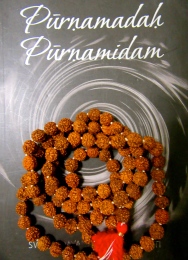The extraordinary properties and celestial powers of Rudraksha have been illuminated in the ancient Hindu Shastras such as Rudraksha Jabala Upanishad, Padma Purana, Shiva Mahapurana, Devi Purana and Bhagavat Purana.
In the Shiva Mahapurana, Shiva told Parvati, “My love, any deity can be worshipped with the Rudraksha…Lords Shiva, Vishnu, Devi, Ganesh, Surya and other Gods also will be pleased to see a person who wears a Rudraksha.”
Rudraksha literally means “the tears of God,” and specifically, the god, Shiva. It is said, while contemplating the world’s suffering, Shiva unexpectedly began to cry tears of compassion. As his tears trickled to Earth, he transformed them to seeds, to support those seeking freedom from suffering and union with the Divine.
Rudraksha embodies the connection between earth and heaven — between man and god.  Hence Rudraksha is an object of worship, and also a form of prayer to reach the higher self.
Hence Rudraksha is an object of worship, and also a form of prayer to reach the higher self.
It is believed that the seed of rudraksha contains the secrets of the whole evolution of Creation. The sages and yogis of the Himalayas, who live according to the Eternal Natural Law of Sanatana Dharma, have been wearing rudraksha for centuries in the spirit of a fearless life on their path to liberation.
As per the ancient Indian scriptures mentioned above, each rudraksha is associated with a specific deity. This divine power shields against all forms of negativity. Lord Shiva is always depicted wearing rosaries of rudraksha beads on his head, arms and hands. There are 14 chants to Shiva that are associated with the rudraksha, which are known as beej mantras.
The word rudraksha originates from two words: “rudra “and “aksha.” Aksha means eye. Rudra and aksha means “the one who is capable of looking at and doing everything (for example, the third eye).”
“Rudra” means the one who weeps. “A” means “to receive” and “ksha” means “to give.” Hence, aksha signifies the ability to receive or give. Rudraksha is the one that has the gift to dry our tears and offer contentment.
Rudraksha beads are believed to provide good support for those who are continually in transit and stay in a variety of places – as it helps to form a cocoon of the wearer’s own energy.
The rudraksha seed is produced by several varieties of a large evergreen broad-leaved tree, predominantly in the area from the Gangetic plain in the foothills of the Himalayas, to South-East Asia (and beyond). It is an evergreen tree that grows rapidly. The rudraksha tree begins bearing fruit in three to four years, and harvests one to two thousand fruits annually. The Himalayan ascetics survive only on these fruits, which are known as amrutphal (Fruits of Nectar), which quench thirst. The seed is enclosed by an outer husk of blue colour when fully ripe, and subsequently, are also known as blueberry beads.
Rudraksha contains characteristics of gold, copper & electro magnetic power, which is strengthened by cosmic rays and transfer in to the human body for optimal health due to its highly effective conductor properties. It can cancel the effects of malefic planets to a great extent.
Rudraksha inspires self-confidence, self-courage and encourages a positive attitude in a multi-discipline theme. It assists in preserving good health, and is used for remedy in various ailments in Ayurveda. It also contains anti-aging properties. The beads are effective in alleviating stress (including hypertension, depression, high blood pressure and other mood disorders), thus blessing the wearer with greater peace of mind. Rudraksha stimulates clarity, sharpens the mind, and increases the power of intuition.
Rudraksha can also shift the karma of the wearer, leading one naturally to the right path of truth and purpose, making the pace along the path quicker and progress simply.
This article was originally published for Salt Spring Malas.
Interesting that Shiva wore these on his head. A friend of mine once remarked about how some Buddha statues have him wearing what looks like a hat of rudraksha beads. So I wondered about that. But if Shiva wore them, Buddha very well could have too.
LikeLiked by 1 person
Indeed! Truth is EVERYWHERE. 🙂
LikeLike
Reblogged this on The Mindful Word.
LikeLiked by 1 person
Thanks for the re-blog friend, much appreciated. 🙂
LikeLike